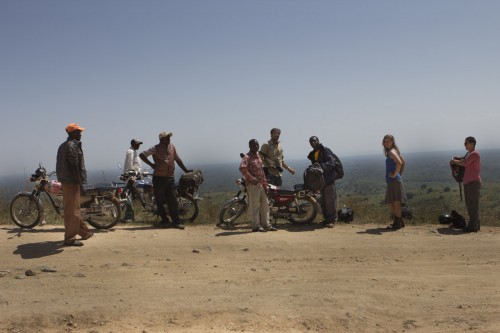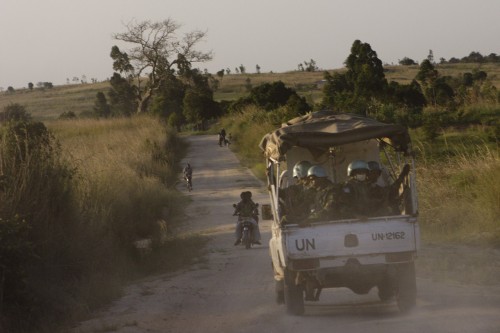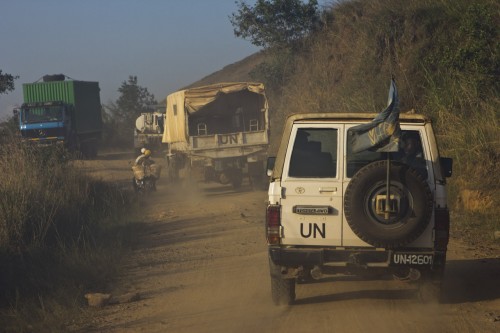[From the hip] So let me get say this right off. Ituri district is absolutely nothing like what you have been told the Eastern DRC is. It’s undeveloped, and it has crap roads – these things are true. But it is also full of really friendly people, to whom we have not had to pay a single bribe, who have really gone out of their way to show us a great time.
There are militia bandits out in the countryside somewhere. And the road to Beni is unsafe until January according to the UN people who live in a giant headquarters up the road that looks like someone buried a battleship in the ground.
But we’ve also been warmly received everywhere we went, by locals and government bureaucrats alike. I’ve eaten some of the best food of my life – both at the UN restaurant, and in back alleys and squirrely little restaurants outside. Black beans of some kind, fried sweet banana, mashed sweet potato and, in the case of the aforementioned UN bar/club/food stop in Bunia, a vegetable burger that brought me close to weeping in happiness.
Getting in
We arrived in Kasenyi, on the border with Lake Albert, some time on Monday (I think? It’s a blur). It was still 45km from there to Bunia, and nobody was willing to do it late in the day. Including us, to be honest. So we overnighted and then pushed through to the town the next day on the back of small-engined Indian motorbikes. The road was terrible, but by no means the worst I have ever seen. The route also crossed a mountain range on the DRC side of the Rift Valley, with views from the top that go on for miles.

Those bikes there are called 'boda bodas'. From the fact that they started out ferrying people across a border somewhere in East Africa. The name stuck, and the bikes spread. As far as Ituri district even.
The first roadblock we encountered was one with two sleepy FARDC officers hanging out at a moderately large home-made speed hump. They were likely looking for cigarettes, or a toll (around $0.50 if you are a local, presumably more for four mzungus on the back of bikes). We will never know.The first bike got stopped, but the four others caught up fairly soon after, and the two FARDC troopers trying to hold us all at the roadbloack was comparable to herding cats. Whichever bike they looked at would sit smiling, while the other three or four edged on a foot. Half a foot. A few inches. Then one broke free and the rest followed, leaving the checkpoint in 100cc engine dust behind us.
The subsequent roadblocks (there were at least six) were a mix of either running through completely, to the impotent shouts of a couple of soldiers, or were far more genial affairs at the larger ones. The officers would wave us through with large smiles and shouts of ‘bonjour!’. I’m really not sure what I expected in the Congolese countryside, but this was nothing like it. There’s some pretty sweet footage of this and other nutty rides in the countryside that I wil never, ever be able to upload from here, but which I will most certainly share when I am back in the lands of the faster Internet.
This includes finding ourselves stuck in what passes for a traffic jam in these parts, thanks to a UN convoy heading back to Bunia from a remote posting out somewhere close to the town of Bogoro.

The front of the UN traffic jam, two trucks, a water tanker and an ambulance later. I would truly hate to be one of those guys on the uncomfortable-looking seats at the back.
All of which is really not intended to reinforce the horrible impressions of the Eastern DRC that you see in the media. Yes, the things you read about happen. And the area is massively underdeveloped. And there is a lot of army. And you cannot get chocolate anywhere.
But this part of it, at least, is peaceful. People grow crops here, raise kids, send them to school. There is even a university such as it is. What you read in the news is the tender edge of wounds that run deep into history, but the energy of this place is not those things. It’s so much safer, and so much more hopeful than you are told it is.

In the evening, with the right light and the feet to take you there, the mountains near Bunia look a little like this. Particularly if you are standing in a giant field of cassava. As I clearly must have been.


